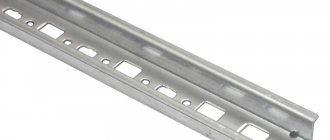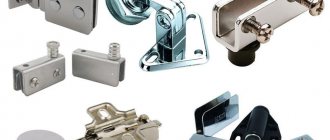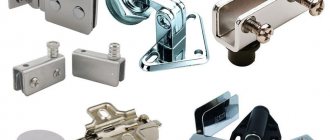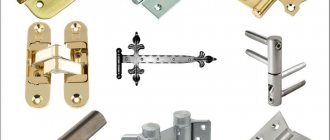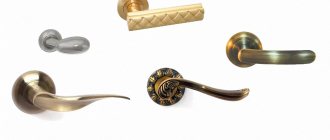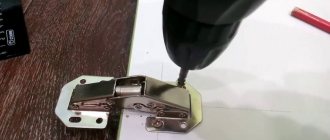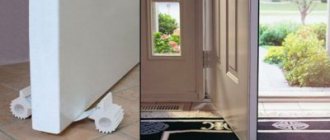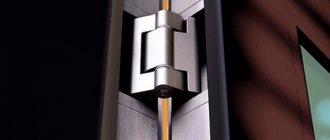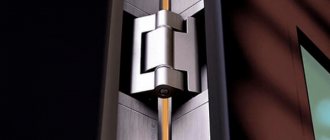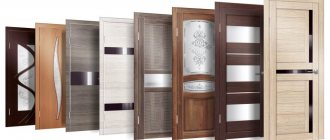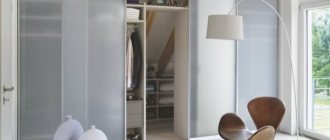Classification of door hinges
Incorrectly selected hinges can cause many inconveniences, misalignment of doors and unnecessary expenses. Therefore, let's first understand the varieties. Door hinges are classified according to several criteria:
- at the installation site;
- according to the method of attachment to the box;
- according to the material of manufacture;
- by type of construction.
2.jpg
Door furniture
Depending on the installation location - either hinges for entrance doors or interior doors. It is clear that the input loops are more durable and massive. A design feature of input loops is also that they are often equipped with a special mechanism that prevents their removal.
Before going to the store
Before you go looking for door hinges, you need to clarify what features the door design has. Please note the following points:
- is there a porch;
- what is the weight of the canvas;
- how intensively the door will be used;
- in which direction the sash opens;
- width of the door leaf;
- what degree of burglary resistance is required to be ensured.
It remains to decide which loops to choose and in what quantity.
Material
Domestic and foreign manufacturers present models made of various metals and alloys, distinguished by special properties.
- Brass plated. The base is aluminum, zinc or steel alloys. The brass coating ensures easy movement of rubbing parts and protects them from corrosion.
- Brass. Strong and durable material easily withstands high loads and the impressive weight of the door leaf. They are produced in polished form or coated with chrome.
- Steel. The most durable products. Still, their price is appropriate. Therefore, installing them on interior walls is not always economical. In most cases, they are used for entrance groups.
Design features of door hinges
3.jpg
Mortise hinges are almost invisible
We will continue to talk about ordinary interior doors. Structurally, they are divided into several varieties:
4.jpg
Door hinges are the most important part of the furniture
5.jpg
Variety of door hinges
6.jpg
Overhead hinges can become a door decoration
- overhead, or removable;
- mortise - butterfly hinges;
- corner;
- universal;
- screw-in;
7.jpg
Door with hidden hinges
- hidden;
- bilateral.
Now - about each variety in more detail.
8.jpg
Hinges for glass doors
Card loops: pros and cons
9.jpg
Overhead (card) loops
Card, removable, overhead loops are the simplest of all listed and, perhaps, the most common. They are two plates, one of which has a funnel, the other has a pin, so they are attached to each other. These loops have been known since time immemorial. They were forged by hand by blacksmiths, and it was impossible to find two identical products. Today, of course, hinges are stamped on a conveyor belt and have standard sizes. The reasons for their continued popularity are that:
- Very simple installation, fastened with ordinary screws.
- Allows you to quickly remove the door from its hinges when required.
- They have a high load capacity. A heavy door made of solid oak, for example, is quite capable of them.
- They are durable. Warranty – up to 10 years. In fact, they sometimes worry about the door itself.
- They work smoothly and softly.
The disadvantages are that you need to know the side of the door - left hinge, right hinge. They do not replace each other in any way. A door with such hinges will not suit every interior style. Another disadvantage is a continuation of dignity. The door is easy to remove from its hinges and carry away.
A butterfly loop is the same as an overlay loop that folds down to the thickness of one card due to a cutout that resembles butterfly wings, hence the name. These loops have their own specific advantages and disadvantages. Pros:
10.jpg
Butterfly loop
- Fast and easy installation.
- They fit equally to both left and right doors.
- They are inexpensive.
Unfortunately, there are more disadvantages:
- Low load capacity. They will not withstand a heavy solid wood door.
- They cannot be removed like regular card loops.
- Unfortunately, they are often of poor quality. One cannot expect long service from them.
- Due to the low load-bearing capacity of these hinges, doors often sag.
- They are visible at the end of the door, which does not look very aesthetically pleasing.
Mortise hinges, which are a type of overhead hinges, are not so noticeable. To install them, a recess is made in the end of the door being mounted, then the hinge is screwed in with screws. As a result, when the door is closed, only the rotary axes of the plates are visible.
11.jpg
Mortise hinges
Decorative overlays
Door hinges are elements that can easily fit into any room thanks to special overlays. Many manufacturers offer a wide selection of linings. They can be made of metal, have a golden or silver gloss, or a matte finish. Their installation does not require dismantling the structure - they are simply placed on existing canopies and the structure is ready.
Overlays usually come in simple shapes, but you can also get more decorative options that add to the aesthetic and make it more chic. Of course, when making a choice, we must remember the universal principles of aesthetics, which say that the style of all furniture and interior items should not conflict with the doors and their decor.
Universal hinges
Universal hinges, as the name suggests, are suitable for any door. In addition, they have the following advantages:
- Large load capacity. Can support doors weighing up to 80 kilograms. There are simply no heavier interior doors.
- Very durable ones last as long as removable ones. If installed correctly, they will survive the door.
Doors on such hinges cannot be removed so easily. You need a screwdriver and 5 minutes of time. Another disadvantage is that they do not suit every interior style. In a high-tech environment, for example, they will sound dissonant.
Ball inside the axle
The same cannot be said about canopies with a ball bearing inside on the axle. This bearing ball is made of durable steel and is hardened. It is pressed into the axle with lubricant, so that when rotating in the axle, the loop does not deform and its movement is easier. Thus, welded with a ball will last longer.
With ball and adjustment
Features of screw-in hinges
Screw-in hinges are a slightly different story. They consist of two symmetrically located parts with holes for mounting screws. Instead of plates, they have cylinders that screw into the door frame and door leaf. They are best suited for doors with a “European sash”. The fashion for these loops came to us from there. Let's evaluate their advantages and disadvantages. Advantages:
12.jpg
Screw-in hinge
- They are practically invisible, the door looks neat.
- They can be adjusted, they allow you to eliminate distortions.
- The cheapest of what the market offers.
13.jpg
Screw-in hinge in door
And here are the disadvantages:
- Since they screw directly into the door, the panel must be thick enough.
- Low load capacity, no more than 30 kilograms.
- Installation is somewhat more complicated; it requires a template.
- Two loops are usually not enough. It is recommended to hang even light doors on three hinges.
- It is impossible to remove the door from the frame without a screwdriver.
Screw-in hinges are not suitable for our standard doors.
Corner and double-sided hinges
14.jpg
Pendulum loop
Corner hinges differ from ordinary overhead hinges only in that instead of plates they have profile corners. They are fastened with mortise screws and are suitable for rebated doors. Double-sided loops are another type of card canopy. They are characterized by the fact that they allow the door to open in both directions - inward and outward. They are also called bar bars, and are usually installed in public or drinking establishments. Inside the apartment - not advisable.
External welded
Welded canopies are used in many places, they are installed both on metal entrance doors and on gates, gates... Drop-shaped and cylindrical have the same modifications such as:
- with an ordinary axle - already a rarity;
- an axle with a pressed ball from a bearing;
- with a regular axle with 1 bearing;
- with an open bearing - found in cylindrical bearings, used in rare cases, since it is not resource-intensive during operation;
Modifications of teardrop-shaped ones from Italian manufacturers:
- machined axle for roller bearing with thrust bearing;
- with two bearings on the axle at the top and bottom - the structure is hidden inside;
Drop-shaped and cylindrical hinges differ mainly only in appearance. But because drop-shaped ones are more modern welded canopies; they have more different modifications of the insides than cylindrical ones. We will consider the same modifications that are found in both teardrop-shaped and cylindrical ones.
Hidden hinges
15.jpg
Hidden door hinges in the interior
Hidden hinges, they are also called secret hinges, because when the door is closed they are completely invisible. They have at least three rotary axes and their installation is quite complicated. Doors are equipped with such hinges directly at the factory. Finding them in stores is very difficult. They allow you to adjust the door in three planes - horizontally, vertically and by pressing force. To do this, simply tighten the screws without removing the canvas. These are the very doors that are completely suitable for modern styles - high-tech, modern, futurism and so on. Well, now let’s expose this innovation:
16.jpg
Hidden hinges
- They have a small opening angle. You cannot bring large items through such a door.
- They are not visible only when the door is closed. When open, the entire structure faces out.
- Special requirements for the thickness of the canvas. The door should be no thinner than 4 centimeters.
- Complicated and expensive insertion.
- It is very difficult to remove the door from its hinges if repairs are needed.
- The hinges themselves are also very expensive.
Whether it makes sense to install such loops in an apartment is up to you to decide. Moreover, if you are an uncompromising fan of sharply modern styles, then this is the only option.
teardrop-shaped
If you look at the “droplet” canopies from above - from the end, then their name will immediately become clear. The drop-shaped shape was invented to make it easier to weld it to the workplace. The drop-shaped loop is made in both two-section and three-section.
With two bearings on the axle at the top and bottom - the structure is hidden inside.
Drop-shaped ones are more often found with a bearing; if without it, then with a ball. Either they are generally ordinary, but only with a washer, or the axle is machined as if with a washer.
What are door hinges made of?
As for the material of manufacture, there is not much variety. The hinges are made of stainless steel and brass. They are covered with enamel, chrome plated, made “gold”, “bronze” and so on. Briefly, the characteristics of these materials.
Brass hinges are not subject to corrosion and abrasion. However, they may darken over time. It's another matter if it is a brass-zinc alloy. It is not afraid of corrosion and is very durable.
Steel hinges are the cheapest, they are simply stamped. Yes, they are durable, but squeaking may occur over time. If it is ordinary steel, not stainless steel, then it is still susceptible to corrosion.
Materials used
Several types of materials are used to make door hinges, which determines their quality and appearance:
Steel – provides a margin of safety and long-term operation of canopies. The material is exposed to external factors and needs a protective coating. Steel fittings can withstand the weight of heavy door panels without deformation.
Brass is the best option for entrance and interior doors. The material is well processed, is distinguished by its plasticity, resistance to corrosion and weather factors, and ease of use. After polishing or chrome plating, the hinges acquire a beautiful shine.
Brass plating - allows you to give canopies an attractive appearance and protects against rust. In manufacturing, alloys based on steel, aluminum and zinc are used, coated with a layer of brass that does not darken or wear out. Manufacturers offer many options for finishing fittings. To do this, colored enamel and decorative coatings like gold, silver, platinum or bronze are applied.
Stainless steel is durable and practical, not afraid of corrosion and wear. It looks solid after processing and does not require a protective and decorative coating.
